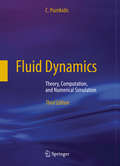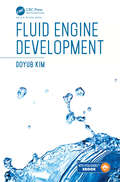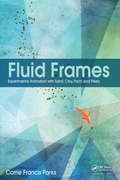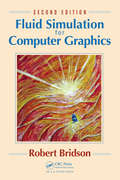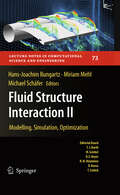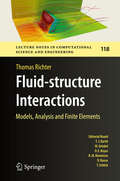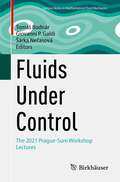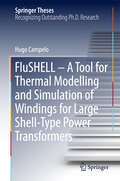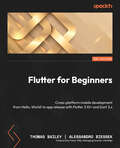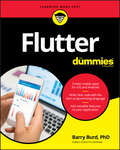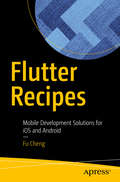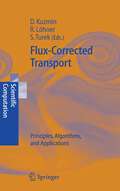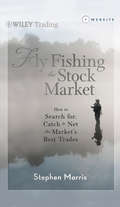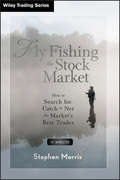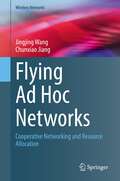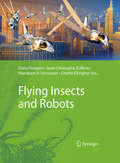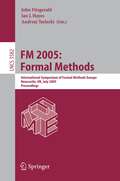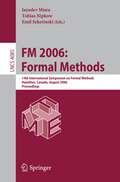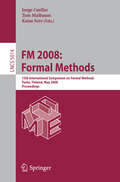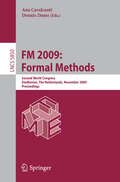- Table View
- List View
Fluid Dynamics: Theory, Computation, and Numerical Simulation
by C. PozrikidisThis book provides an accessible introduction to the basic theory of fluid mechanics and computational fluid dynamics (CFD) from a modern perspective that unifies theory and numerical computation. Methods of scientific computing are introduced alongside with theoretical analysis and MATLAB® codes are presented and discussed for a broad range of topics: from interfacial shapes in hydrostatics, to vortex dynamics, to viscous flow, to turbulent flow, to panel methods for flow past airfoils.The third edition includes new topics, additional examples, solved and unsolved problems, and revised images. It adds more computational algorithms and MATLAB programs. It also incorporates discussion of the latest version of the fluid dynamics software library FDLIB, which is freely available online. FDLIB offers an extensive range of computer codes that demonstrate the implementation of elementary and advanced algorithms and provide an invaluable resource for research, teaching, classroom instruction, and self-study.This book is a must for students in all fields of engineering, computational physics, scientific computing, and applied mathematics. It can be used in both undergraduate and graduate courses in fluid mechanics, aerodynamics, and computational fluid dynamics. The audience includes not only advanced undergraduate and entry-level graduate students, but also a broad class of scientists and engineers with a general interest in scientific computing.
Fluid Engine Development
by Doyub KimFrom the splash of breaking waves to turbulent swirling smoke, the mathematical dynamics of fluids are varied and continue to be one of the most challenging aspects in animation. Fluid Engine Development demonstrates how to create a working fluid engine through the use of particles and grids, and even a combination of the two. Core algorithms are explained from a developer’s perspective in a practical, approachable way that will not overwhelm readers. The Code Repository offers further opportunity for growth and discussion with continuously changing content and source codes. This book helps to serve as the ultimate guide to navigating complex fluid animation and development. Explains how to create a fluid simulation engine from scratch Offers an approach that is code-oriented rather than math-oriented, allowing readers to learn how fluid dynamics works with code, with downloadable code available Explores various kinds of simulation techniques for fluids using particles and grids Discusses practical issues such as data structure design and optimizations Covers core numerical tools including linear system and level set solvers
Fluid Engine Development
by Doyub KimFrom the splash of breaking waves to turbulent swirling smoke, the mathematical dynamics of fluids are varied and continue to be one of the most challenging aspects in animation. Fluid Engine Development demonstrates how to create a working fluid engine through the use of particles and grids, and even a combination of the two. Core algorithms are explained from a developer’s perspective in a practical, approachable way that will not overwhelm readers. The Code Repository offers further opportunity for growth and discussion with continuously changing content and source codes. This book helps to serve as the ultimate guide to navigating complex fluid animation and development. Explains how to create a fluid simulation engine from scratch Offers an approach that is code-oriented rather than math-oriented, allowing readers to learn how fluid dynamics works with code, with downloadable code available Explores various kinds of simulation techniques for fluids using particles and grids Discusses practical issues such as data structure design and optimizations Covers core numerical tools including linear system and level set solvers
Fluid Frames: Experimental Animation with Sand, Clay, Paint, and Pixels
by Corrie Francis ParksOnce the realm of a few stalwart artists, animating with sand, clay, and wet paint is now accessible for all filmmakers with an experimental frame of mind. Created directly under the camera with frame-by-frame stopmotion, this "fluid frame animation" provides a completely unique visual world for animators. While pioneering animators such as Caroline Leaf, Alexander Petrov, and Ishu Patel paved the way, the availability of frame capture programs, compositing software and digital workflow is opening up new avenues of exploration for artists of all experience levels. This book will walk you through setting up your studio, choosing and working with your materials, and combining the physical under-the-camera production with digital compositing and effects to enhance your animation.· Firsthand advice from experimental animation veterans and rising stars in the field· Covers the digital aspects of experimental animation, including the latest techniques in After Effects CC· Tutorials and source files for under-the-camera approaches and After Effects enhancements on the book’s companion website In addition to the practical advice, you’ll find historical and contemporary examples of successful films, step-by-step tutorials for working under the camera and working with the footage digitally, and interviews and tips from artists who are currently pushing the boundaries in these experimental mediums. Stacked with information and images from over 30 artists, this book is an indispensable resource for both the student and professional wishing to get their hands dirty in an increasingly digital world.
Fluid Frames: Experimental Animation with Sand, Clay, Paint, and Pixels
by Corrie Francis ParksOnce the realm of a few stalwart artists, animating with sand, clay, and wet paint is now accessible for all filmmakers with an experimental frame of mind. Created directly under the camera with frame-by-frame stopmotion, this "fluid frame animation" provides a completely unique visual world for animators. While pioneering animators such as Caroline Leaf, Alexander Petrov, and Ishu Patel paved the way, the availability of frame capture programs, compositing software and digital workflow is opening up new avenues of exploration for artists of all experience levels. This book will walk you through setting up your studio, choosing and working with your materials, and combining the physical under-the-camera production with digital compositing and effects to enhance your animation.· Firsthand advice from experimental animation veterans and rising stars in the field· Covers the digital aspects of experimental animation, including the latest techniques in After Effects CC· Tutorials and source files for under-the-camera approaches and After Effects enhancements on the book’s companion website In addition to the practical advice, you’ll find historical and contemporary examples of successful films, step-by-step tutorials for working under the camera and working with the footage digitally, and interviews and tips from artists who are currently pushing the boundaries in these experimental mediums. Stacked with information and images from over 30 artists, this book is an indispensable resource for both the student and professional wishing to get their hands dirty in an increasingly digital world.
Fluid Simulation for Computer Graphics
by Robert BridsonA practical introduction, the second edition of Fluid Simulation for Computer Graphics shows you how to animate fully three-dimensional incompressible flow. It covers all the aspects of fluid simulation, from the mathematics and algorithms to implementation, while making revisions and updates to reflect changes in the field since the first edition. Highlights of the Second Edition New chapters on level sets and vortex methods Emphasizes hybrid particle–voxel methods, now the industry standard approach Covers the latest algorithms and techniques, including: fluid surface reconstruction from particles; accurate, viscous free surfaces for buckling, coiling, and rotating liquids; and enhanced turbulence for smoke animation Adds new discussions on meshing, particles, and vortex methods The book changes the order of topics as they appeared in the first edition to make more sense when reading the first time through. It also contains several updates by distilling author Robert Bridson’s experience in the visual effects industry to highlight the most important points in fluid simulation. It gives you an understanding of how the components of fluid simulation work as well as the tools for creating your own animations.
Fluid Simulation for Computer Graphics
by Robert BridsonA practical introduction, the second edition of Fluid Simulation for Computer Graphics shows you how to animate fully three-dimensional incompressible flow. It covers all the aspects of fluid simulation, from the mathematics and algorithms to implementation, while making revisions and updates to reflect changes in the field since the first edition. Highlights of the Second Edition New chapters on level sets and vortex methods Emphasizes hybrid particle–voxel methods, now the industry standard approach Covers the latest algorithms and techniques, including: fluid surface reconstruction from particles; accurate, viscous free surfaces for buckling, coiling, and rotating liquids; and enhanced turbulence for smoke animation Adds new discussions on meshing, particles, and vortex methods The book changes the order of topics as they appeared in the first edition to make more sense when reading the first time through. It also contains several updates by distilling author Robert Bridson’s experience in the visual effects industry to highlight the most important points in fluid simulation. It gives you an understanding of how the components of fluid simulation work as well as the tools for creating your own animations.
Fluid-Structure Interaction: Modelling, Simulation, Optimisation (Lecture Notes in Computational Science and Engineering #53)
by Hans-Joachim Bungartz Michael SchäferThis volume in the series Lecture Notes in Computational Science and Engineering presents a collection of papers presented at the International Workshop on FSI, held in October 2005 in Hohenwart and organized by DFG's Research Unit 493 "FSI: Modeling, Simulation, and Optimization". The papers address partitioned and monolithic coupling approaches, methodical issues and applications, and discuss FSI from the mathematical, informatics, and engineering points of view.
Fluid Structure Interaction II: Modelling, Simulation, Optimization (Lecture Notes in Computational Science and Engineering #73)
by Hans-Joachim Bungartz Miriam Mehl Michael SchäferFluid-structure interactions (FSI), i.e., the interplay of some moveable or deformable structure with an internal or surrounding fluid, are among the most widespread and most challenging coupled or multi-physics problems. Although much has been accomplished in developing good computational FSI methods and despite convincing solutions to a number of classes of problems including those presented in this book, there is a need for more comprehensive studies showing that the computational methods proposed are reliable, robust, and efficient beyond the classes of problems they have successfully been applied to.This volume of LNCSE, a sequel to vol. 53, which contained, among others, the first numerical benchmark for FSI problems and has received considerable attention since then, presents a collection of papers from the "First International Workshop on Computational Engineering - special focus FSI," held in Herrsching in October 2009 and organized by three DFG-funded consortia. The papers address all relevant aspects of FSI simulation and discuss FSI from the mathematical, informatical, and engineering perspective.
Fluid-structure Interactions: Models, Analysis and Finite Elements (Lecture Notes in Computational Science and Engineering #118)
by Thomas RichterThis book starts by introducing the fundamental concepts of mathematical continuum mechanics for fluids and solids and their coupling. Special attention is given to the derivation of variational formulations for the subproblems describing fluid- and solid-mechanics as well as the coupled fluid-structure interaction problem. Two monolithic formulations for fluid-structure interactions are described in detail: the well-established ALE formulation and the modern Fully Eulerian formulation, which can effectively deal with problems featuring large deformation and contact. Further, the book provides details on state-of-the-art discretization schemes for fluid- and solid-mechanics and considers the special needs of coupled problems with interface-tracking and interface-capturing techniques. Lastly, advanced topics like goal-oriented error estimation, multigrid solution and gradient-based optimization schemes are discussed in the context of fluid-structure interaction problems.
Fluids Under Control: The 2021 Prague-Sum Workshop Lectures (Advances in Mathematical Fluid Mechanics)
by Tomáš Bodnár Giovanni P. Galdi Šárka NečasováThis volume presents state-of-the-art developments in theoretical and applied fluid mechanics. Chapters are based on lectures given at a workshop in the summer school Fluids under Control, held in Prague on August 25, 2021. Readers will find a thorough analysis of current research topics, presented by leading experts in their respective fields. Specific topics covered include: Magnetohydrodynamic systemsThe steady Navier-Stokes-Fourier systemBoussinesq equationsFluid-structure-acoustic interactions Fluids under Control will be a valuable resource for students interested in mathematical fluid mechanics.
FluSHELL – A Tool for Thermal Modelling and Simulation of Windings for Large Shell-Type Power Transformers (Springer Theses)
by Hugo CampeloThis thesis addresses a novel application of network modelling methodologies to power transformers. It develops a novel thermal model and compares its performance against that of a commercial computational fluid dynamics (CFD) code, as well as in experiments conducted in a dedicated setup built exclusively for this purpose. Hence, the thesis cross-links three of the most important aspects in high-quality research: model development, simulation and experimental validation.Network modelling is used to develop a tool to simulate the thermal performance of power transformers, widely acknowledged to be critical assets in electrical networks. After the strong de-regulation of electricity markets and de-carbonization of worldwide economies, electrical networks have been changing fast. Both asset owners and equipment manufacturers are being driven to develop increasingly accurate modelling capabilities in order to optimize either their operation or their design. Temperature is a critical parameter in every electric machine and power transformers are no exception. As such, the thesis is relevant for a wide range of stakeholders, from utilities to power transformer manufacturers, as well as researchers interested in the energy industry. It is written in straightforward language and employs a highly pedagogic approach, making it also suitable for non-experts.
Flutter for Beginners: Cross-platform mobile development from Hello, World! to app release with Flutter 3.10+ and Dart 3.x
by Thomas Bailey Alessandro BiessekFollow this step-by-step illustrated guide to launch your own Flutter apps and gain hands-on experienceKey FeaturesGet up to speed with the basics of Dart programming and delve into Flutter developmentLearn about Flutter widgets, plugins, and animations to create a high-quality, user-friendly appPackage and deploy your Flutter apps to achieve native-like performancePurchase of the print or Kindle book includes a free PDF eBookBook DescriptionThere have been many attempts at creating frameworks that are truly cross-platform, but most struggle to create a native-like experience at high-performance levels. Flutter achieves this with an elegant design and a wealth of third-party plugins, solidifying its status as the future of mobile app development. If you are a mobile developer who wants to create rich and expressive native apps with the latest Google Flutter framework, this book is for you. You’ll start with the basics of cross-platform development frameworks, specifically Flutter. You’ll then explore the Dart programming language which is the foundation of the Flutter framework. Next, you’ll get a feel for Flutter and how to create your first app, followed by an exploration of the various popular plugins that supplement the Flutter framework. Finally, you’ll explore testing and app release, including some common glitches that you may experience. By the end of this book, you’ll be well-equipped to create and release a basic Flutter app along with gaining a solid understanding of the Flutter framework and Dart language.What you will learnUnderstand the Flutter framework and cross-platform developmentAcclimate the fundamentals of the Dart programming languageExplore Flutter widgets, the core widget library, and stateful and stateless widgetsDiscover the complete development lifecycle, including testing and debuggingGet familiar with both the mobile and web app release processesDig deeper into more advanced Flutter concepts like animationExplore common Flutter plugins ad how to use themDiscover the Flutter community and how to stay up-to-dateWho this book is forIf you are an existing mobile developer seeking a better way to develop cross-platform apps, an existing software developer looking to explore mobile app development, or someone investigating mobile apps and simply wants to know what the Flutter fuss is about, this is the book for you. Prior knowledge of Flutter and Dart is not required.
Flutter For Dummies
by Barry BurdCreate awesome iOS and Android apps with a single tool! Flutter is an app developer’s dream come true. With Google’s open source toolkit, you can easily build beautiful apps that work across platforms using a single codebase. This flexibility allows you to get your work out to the widest possible audience. Flutter is already being used by thousands of developers worldwide in a market where billions of apps are downloaded every year. Now is the right time to get ahead of the curve with this incredible tool. Flutter for Dummies is your friendly, ground-up route to creating multi-platform apps. From how to construct your initial frameworks to writing code in Dart, you’ll find the essentials you need to ride the Flutter revolutionary wave to success. This book includes guidance on how to create an intuitive and stunning UI, add interactivity, and easily pull in data. You’ll also see how Flutter features like Hot Reload—providing sub-second refreshes as you refine your work—help you make sure your app is a delight to use. · Start simple: follow steps to build a basic app · It’s alive! Keep connected to online data · It moves! Make things fun with animated features · Get the word out: use tips to expand your audience Whether you’re a fledgling developer or an expert wanting to add a slick feather to your programming cap, join the Flutter revolution now and soar above the rest!
Flutter For Dummies
by Barry BurdCreate awesome iOS and Android apps with a single tool! Flutter is an app developer’s dream come true. With Google’s open source toolkit, you can easily build beautiful apps that work across platforms using a single codebase. This flexibility allows you to get your work out to the widest possible audience. Flutter is already being used by thousands of developers worldwide in a market where billions of apps are downloaded every year. Now is the right time to get ahead of the curve with this incredible tool. Flutter for Dummies is your friendly, ground-up route to creating multi-platform apps. From how to construct your initial frameworks to writing code in Dart, you’ll find the essentials you need to ride the Flutter revolutionary wave to success. This book includes guidance on how to create an intuitive and stunning UI, add interactivity, and easily pull in data. You’ll also see how Flutter features like Hot Reload—providing sub-second refreshes as you refine your work—help you make sure your app is a delight to use. · Start simple: follow steps to build a basic app · It’s alive! Keep connected to online data · It moves! Make things fun with animated features · Get the word out: use tips to expand your audience Whether you’re a fledgling developer or an expert wanting to add a slick feather to your programming cap, join the Flutter revolution now and soar above the rest!
Flutter Recipes: Mobile Development Solutions for iOS and Android
by Fu ChengTake advantage of this comprehensive reference to solving common problems when developing with Flutter. Along with an introduction to the basic concepts of Flutter development, the recipes in this book cover all important aspects of this emerging technology, including development, testing, debugging, performance tuning, app publishing, and continuous integration. Although Flutter presents a rich, cross-platform mobile development framework, helpful documentation is not easily found. Here you’ll review solutions to various scenarios and use creative, tested ways to accomplish everything from simple to complex development tasks. Flutter is developed using Dart and contains a unique technology stack that sets it apart from its competitors. This book takes the mystery out of working with the Dart language and integrating Flutter into your already existing workflows and development projects. With Flutter Recipes, you’ll learn how to build and deploy apps freshly started in Flutter, as well as apps already in progress, while side-stepping any potential roadblocks you may face along the way. What You'll LearnDebug with Dart ObservatoryProgram accessibility and localization featuresBuild and release apps for iOS and AndroidIncorporate reactive programmingWho This Book Is ForMobile developers with some experience in other frameworks who would like to work with the growing and popular Flutter.
Flux-Corrected Transport: Principles, Algorithms, and Applications (Scientific Computation)
by Dmitri Kuzmin Rainald Löhner Stefan TurekAddressing students and researchers as well as CFD practitioners, this book describes the state of the art in the development of high-resolution schemes based on the Flux-Corrected Transport (FCT) paradigm. Intended for readers who have a solid background in computational fluid dynamics, the book begins with historical notes by J.P. Boris and D.L. Book. Review articles that follow describe recent advances in the design of FCT algorithms as well as various algorithmic aspects. The topics addressed in the book and its main highlights include: the derivation and analysis of classical FCT schemes, with special emphasis on the underlying physical and mathematical constraints; flux limiting for hyperbolic systems; generalization of FCT to implicit time-stepping and finite element discretizations on unstructured meshes and its role as a subgrid scale model for Monotonically Integrated Large Eddy Simulation (MILES) of turbulent flows. The proposed enhancements of the FCT methodology also comprise the prelimiting and 'failsafe' adjustment of antidiffusive fluxes, the use of characteristic variables, and iterative flux correction. The cause and cure of detrimental clipping/terracing effects are discussed. Many numerical examples are presented for academic test problems and large-scale applications alike.
Fly Fishing the Stock Market: How to Search for, Catch, and Net the Market's Best Trades (Wiley Trading #578)
by Stephen MorrisHow the strategies and tactics of fly fishing can translate to improved trading performance Much like trading, successful fly fishing requires both an understanding of "big picture" conditions and the ability to implement tactical techniques to actually catch the fish. In Fly Fishing the Stock Market, Dr. Stephen Morris compares his method for trading stocks with his favorite past time, fly fishing—providing fresh insights into his successful trading approach. Engaging and accessible, this book skillfully describes how Morris applied this approach to generate an astounding 268% growth in his account in the volatile and confusing, post-financial crisis markets. Morris explains how he uses technical indicators to determine what he calls the "market season" and how he then zeros in on individual stock patterns to make his trades. He also reveals unique tools, such as the Market Timing Monitor and Weather Station, which give him a sense of the market's long-term condition and provides the basis for his trading and risk management strategies. Filled with the authenticity of a real trader figuring out how to uncover profitable trading opportunities A companion Website contains supplementary material that allows you to learn in a hands-on fashion long after closing the book Provides a compelling portrait of how a successful trader thinks about markets, develops a method, and then implements the method in real time The author's spectacular returns are backed by publicly documented records Just like fly fishing, traders must adjust their approach constantly because market conditions constantly change. This book will help you achieve this elusive goal, and capture consistent profits in the process.
Fly Fishing the Stock Market: How to Search for, Catch, and Net the Market's Best Trades (Wiley Trading #578)
by Stephen MorrisHow the strategies and tactics of fly fishing can translate to improved trading performance Much like trading, successful fly fishing requires both an understanding of "big picture" conditions and the ability to implement tactical techniques to actually catch the fish. In Fly Fishing the Stock Market, Dr. Stephen Morris compares his method for trading stocks with his favorite past time, fly fishing—providing fresh insights into his successful trading approach. Engaging and accessible, this book skillfully describes how Morris applied this approach to generate an astounding 268% growth in his account in the volatile and confusing, post-financial crisis markets. Morris explains how he uses technical indicators to determine what he calls the "market season" and how he then zeros in on individual stock patterns to make his trades. He also reveals unique tools, such as the Market Timing Monitor and Weather Station, which give him a sense of the market's long-term condition and provides the basis for his trading and risk management strategies. Filled with the authenticity of a real trader figuring out how to uncover profitable trading opportunities A companion Website contains supplementary material that allows you to learn in a hands-on fashion long after closing the book Provides a compelling portrait of how a successful trader thinks about markets, develops a method, and then implements the method in real time The author's spectacular returns are backed by publicly documented records Just like fly fishing, traders must adjust their approach constantly because market conditions constantly change. This book will help you achieve this elusive goal, and capture consistent profits in the process.
Flying Ad Hoc Networks: Cooperative Networking and Resource Allocation (Wireless Networks)
by Jingjing Wang Chunxiao JiangRelying on unmanned autonomous flight control programs, unmanned aerial vehicles (UAVs) equipped with radio communication devices have been actively developed around the world. Given their low cost, flexible maneuvering and unmanned operation, UAVs have been widely used in both civilian operations and military missions, including environmental monitoring, emergency communications, express distribution, even military surveillance and attacks, for example. Given that a range of standards and protocols used in terrestrial wireless networks are not applicable to UAV networks, and that some practical constraints such as battery power and no-fly zone hinder the maneuverability capability of a single UAV, we need to explore advanced communication and networking theories and methods for the sake of supporting future ultra-reliable and low-latency applications. Typically, the full potential of UAV network’s functionalities can be tapped with the aid of the cooperation of multiple drones relying on their ad hoc networking, in-network communications and coordinated control. Furthermore, some swarm intelligence models and algorithms conceived for dynamic negotiation, path programming, formation flight and task assignment of multiple cooperative drones are also beneficial in terms of extending UAV’s functionalities and coverage, as well as of increasing their efficiency. We call the networking and cooperation of multiple drones as the terminology ‘flying ad hoc network (FANET)’, and there indeed are numerous new challenges to be overcome before the idespread of so-called heterogeneous FANETs. In this book, we examine a range of technical issues in FANETs, from physical-layer channel modeling to MAC-layer resource allocation, while also introducing readers to UAV aided mobile edge computing techniques.
Flying Insects and Robots
by Dario Floreano Jean-Christophe Zufferey Mandyam V. Srinivasan Charlie EllingtonFlying insects are intelligent micromachines capable of exquisite maneuvers in unpredictable environments. Understanding these systems advances our knowledge of flight control, sensor suites, and unsteady aerodynamics, which is of crucial interest to engineers developing intelligent flying robots or micro air vehicles (MAVs). The insights we gain when synthesizing bioinspired systems can in turn benefit the fields of neurophysiology, ethology and zoology by providing real-life tests of the proposed models. This book was written by biologists and engineers leading the research in this crossdisciplinary field. It examines all aspects of the mechanics, technology and intelligence of insects and insectoids. After introductory-level overviews of flight control in insects, dedicated chapters focus on the development of autonomous flying systems using biological principles to sense their surroundings and autonomously navigate. A significant part of the book is dedicated to the mechanics and control of flapping wings both in insects and artificial systems. Finally hybrid locomotion, energy harvesting and manufacturing of small flying robots are covered. A particular feature of the book is the depth on realization topics such as control engineering, electronics, mechanics, optics, robotics and manufacturing. This book will be of interest to academic and industrial researchers engaged with theory and engineering in the domains of aerial robotics, artificial intelligence, and entomology.
FM 2005: International Symposium of Formal Methods Europe, Newcastle, UK, July 18-22, 2005, Proceedings (Lecture Notes in Computer Science #3582)
by John Fitzgerald Ian J. HayesThis volume contains the proceedings of Formal Methods 2005, the 13th InternationalSymposiumonFormalMethodsheldinNewcastleuponTyne,UK, during July 18–22, 2005. Formal Methods Europe (FME, www.fmeurope.org) is an independent association which aims to stimulate the use of, and research on, formal methods for system development. FME conferences began with a VDM Europe symposium in 1987. Since then, the meetings have grown and have been held about once every 18 months. Throughout the years the symposia have been notablysuccessfulinbringingtogetherresearchers,tooldevelopers,vendors,and users, both from academia and from industry. Formal Methods 2005 con?rms this success. We received 130 submissions to the main conference, from all over the world. Each submission was carefully refereed by at least three reviewers. Then, after an intensive, in-depth discussion, the Program Committee selected 31 papers for presentation at the conference. They form the bulk of this volume. We would like to thank all the Program Committee members and the referees for their excellent and e?cient work. Apart from the selected contributions, the Committee invited three keynote lectures from Mathai Joseph, Marie-Claude Gaudel and Chris Johnson. You will ?nd the abstracts/papers for their keynote lectures in this volume as well. AninnovationfortheFM2005programwasapaneldiscussiononthehistory of formal methods, with Jean-Raymond Abrial, Dines Bjørner, Jim Horning and Cli? Jones as panelists. Unfortunately, it was not possible to re?ect this event in the current volume, but you will ?nd the material documenting it elsewhere (see the conference Web page).
FM 2006: 14th International Symposium on Formal Methods, Hamilton, Canada, August 21-27, 2006, Proceedings (Lecture Notes in Computer Science #4085)
by Jayadev Misra Tobias Nipkow Emil SekerinskiThis book presents the refereed proceedings of the 14th International Symposium on Formal Methods, FM 2006, held in Hamilton, Canada, August 2006. The book presents 36 revised full papers together with 2 invited contributions and extended abstracts of 7 invited industrial presentations, organized in topical sections on interactive verification, formal modelling of systems, real time, industrial experience, specification and refinement, programming languages, algebra, formal modelling of systems, and more.
FM 2008: 15th International Symposium on Formal Methods, Turku, Finland, May 26-30, 2008, Proceedings (Lecture Notes in Computer Science #5014)
by Jorge Cuellar Tom MaibaumThis book presents the refereed proceedings of the 15th International Symposium on Formal Methods, FM 2008, held in Turku, Finland in May 2008. The 23 revised full papers presented together with 4 invited contributions and extended abstracts of 5 invited industrial presentations were carefully reviewed and selected from 106 submissions. The papers are organized in topical sections on programming language analysis, verification, real-time and concurrency, grand chellenge problems, fm practice, runtime monitoring and analysis, communication, constraint analysis, and design.
FM 2009: Second World Congress, Eindhoven, The Netherlands, November 2-6, 2009, Proceedings (Lecture Notes in Computer Science #5850)
by Ana Cavalcanti Dennis Damsth FM 2009, the 16 International Symposium on Formal Methods, marked the 10th an- versary of the First World Congress on Formal Methods that was held in 1999 in Toulouse, France. We wished to celebrate this by advertising and organizing FM 2009 as the Second World Congress in the FM series, aiming to once again bring together the formal methods communities from all over the world. The statistics displayed in the table on the next page include the number of countries represented by the Programme Committee members, as well as of the authors of submitted and accepted papers. Novel this year was a special track on tools and industrial applications. Subm- sions of papers on these topics were especially encouraged, but not given any special treatment. (It was just as hard to get a special track paper accepted as any other paper.) What we did promote, however, was a discussion of how originality, contri- tion, and soundness should be judged for these papers. The following questions were used by our Programme Committee.
